A Barcelona to Madrid drive is one of the most common road trips in Spain. Driving between the two biggest cities in Spain is a great way to see some of the lesser-known parts of the country.
The beauty of this trip is that you have two ways to get there. You can either head to Madrid via Zaragoza, or take the coastal route down to Valencia and then drive inland.
I prefer the coastal route, as there is more to see along the way. That’s the route I will be discussing in this article, though if you want to go via Zaragoza you still can.
As well as Valencia, you will come across sights such as the Roman theatre in Tarragona, a hillside city in Cuenca and the old capital, Toledo.
This Barcelona to Madrid road trip will tell you all need to know about the drive, the stops along the way, what you need with you and how much it will cost!
Disclosure: This article may contain affiliate/compensated links. For full information, please see our full disclosure policy.
Table of Contents
Barcelona to Madrid Drive
Quick Barcelona to Madrid Drive Itinerary
Distance – 955.7 km (593.8 miles)
Time – 7 days
Day 1 – Barcelona to Tarragona: 99.6 km (61.8 miles)
Day 2 – Tarragona to Valencia: 259 km (160.9 miles)
Day 3 – Valencia
Day 4 – Valencia to Albacete: 185 km (114.9 miles)
Day 5 – Albacete to Cuenca: 160 km (99.4 miles)
Day 6 – Cuenca to Toledo: 179 km (111.2 miles)
Day 7 – Toledo to Madrid: 73.1 km (45.4 miles)
Spain is a bigger country than most people think. Despite the distance not looking too far on a map, it will take a while to complete the drive.
If you wanted, you could do this trip in a day but that would be a big waste. You’ll find lots of great places to see along the way and this is what makes road trips fun.
I recommend you take five to seven days to complete this trip. Take your time to explore the various places and if you want to spend 3 days in Valencia, for example, go for it!
You won’t regret doing the trip at a slower pace, but you will regret blasting straight to Madrid without seeing anything along the way!
Before Setting Off
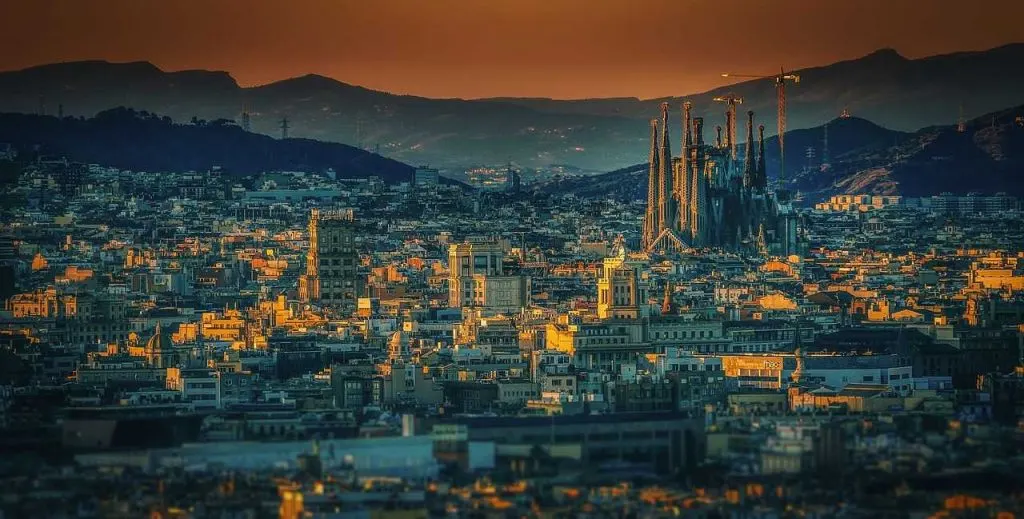
Before you do any road trips in Spain, you should have as much sorted as you can. The most important thing to have is a vehicle in which to do the trip. This can be your own car or one that you rent when you arrive in Barcelona.
If you live in France, it’s not too far to drive down to Barcelona for a road trip. While driving around Europe, my friends and I drove down to Barcelona from Rotterdam. This is something I don’t advise doing unless you have a lot of time.
Unless you don’t live too far from Spain, it’s probably better to fly in and rent a car. One thing you do have to consider is whether you want to do the trip in a car or campervan. The advantage of the campervan is that you won’t need to book accommodation, while a car will likely be cheaper to rent.
If you’re doing the trip in a group of four or more, a campervan makes sense. The car will be very crowded and it won’t be much fun to be in the car driving in-between places.
In short the more of you there is, the more sense it makes to book a campervan. Otherwise, a car is sufficient and you’ll have issues with finding places to stay along the way.
Need to Rent a Car?
You can book a rental car directly with companies, but my advice would be to use Rentalcars.com instead. They are a comparison website, which takes all the prices from the main rental car suppliers and gives you the best price. You can often get an upgrade free of charge when you go to pick up your car too!
If you’re starting your trip in Barcelona, which I recommend, click here to book your rental car. If you’re starting your trip from Madrid, click here to book your rental car.
Important Info
Driving in Spain can be arduous at times due to the distances involved. Although a Barcelona to Madrid drive isn’t overly long, the distances between places mean you’ll spend a lot of time on the road.
It’s important to remember that in Spain, you drive on the right-hand side of the road. If you’re from a country that drives on the left, like me, this is one of the most important things during the trip. It may seem weird at first but you soon get used to it!
Road trips can be tiring so If you feel tired while driving, take a break. Driving can sap you of energy and the longer you drive the more tired you’ll be.
You want to get to wherever you’re going quickly, but this should come at the expense of safety. Check out my road trip food ideas too, to ensure you’re full and well-hydrated while you travel.
Regular breaks should be a big part of your itinerary. This is the best way to counter the lack of energy from driving long distances. Accidents can happen if you’re not careful. You should already be stopping at regular intervals anyway to check out the amazing scenery between Barcelona and Madrid!
Before doing any road trip, ensure that you have proper travel insurance! I use SafetyWing to keep me safe on the road, it’s designed for backpackers and those who travel a lot.
You never know what can happen on the road. Keep yourself protected against all eventualities! Click here to get a quote!
Essential Items to Pack For a Barcelona to Madrid Drive
As well as these items, it’s important to know what to pack for Spain too. The climate in Spain varies a lot depending on where you are and the time of year. Both cities will be hot during the summer, while Madrid will be colder in winter. So pack accordingly!
Don’t forget to take suncream, sunglasses and a hat to protect you from the sun. While loose-fitting clothes are ideal in the hot weather! Jackets, waterproofs and warm clothes are essential during the Autumn and winter months.
Below are a few items you can find on my road trip packing list, I recommend you take on your Barcelona to Madrid road trip, to make the drive that little bit easier!
- Road survival kit
- Car charger
- Portable charger
- Water containers
- Eco water bottle
- Toilet roll
- Bluetooth/Wireless hands-free kit
- Sunglasses
- Trtl Travel Pillow
Why You Should Do a Barcelona to Madrid Road Trip
The simple answer is that not only will you get to visit the two biggest cities in Spain, you’ll get to see a lot of other brilliant places along the way.
Madrid and Barcelona are some of the most interesting places in Spain. I recommend you spend a few days in both places before and after the trip to get a feel for both.
The trip itself highlights how much there is to see in Spain outside of the major cities. There is a lot to see in the country that you might not be aware of.
On this trip, you can visit the beachside city of Tarragona, which has a lot of Roman ruins. Check out the hillside town of Cuenca, where houses are built on top of both deep gorges and visit the old capital of Toledo.
My favourite thing about road trips is that you see a different side of a country and you get to visit places you wouldn’t normally see.
This way you get a better idea of what a country is like and the variations within it. This is certainly true in Spain, which despite its international is a country with a lot of differences.
Driving from Barcelona to Madrid will expose you to a lot of them and provide you with a trip you won’t forget in a hurry!
Where to Stay Between Barcelona and Madrid
Driving between the two biggest cities in Spain, and passing through Valencia, you’ll have a wealth of places to stay that you can choose from.
Many hostels and hotels line the route. Even in smaller cities such as Albacete and Cuenca, you’ll have no difficulty finding accommodation.
If you’re doing this trip in a campervan, you can skip this section as the van will be your home. For everyone else, whether you stay in a hostel or a hostel, or rent an apartment depends on your budget.
Hostels in Spain aren’t overly expensive, while hostels are ideal for the budget traveller. In the end, it comes down to personal preference more than anything!
Below are a few of my recommendations for places to stay during your road trip from Barcelona to Madrid.
Places to Visit on a Barcelona to Madrid Drive
The good thing about this road trip is that are plenty of places to visit along the way. Some of the best places to see in Spain can be found on this route.
As well as those places you’ll see while driving, you must make the most of your time in the two starting cities. They are full of character and with lots to see, it would be a shame to only spend a short amount of time in either.
Barcelona
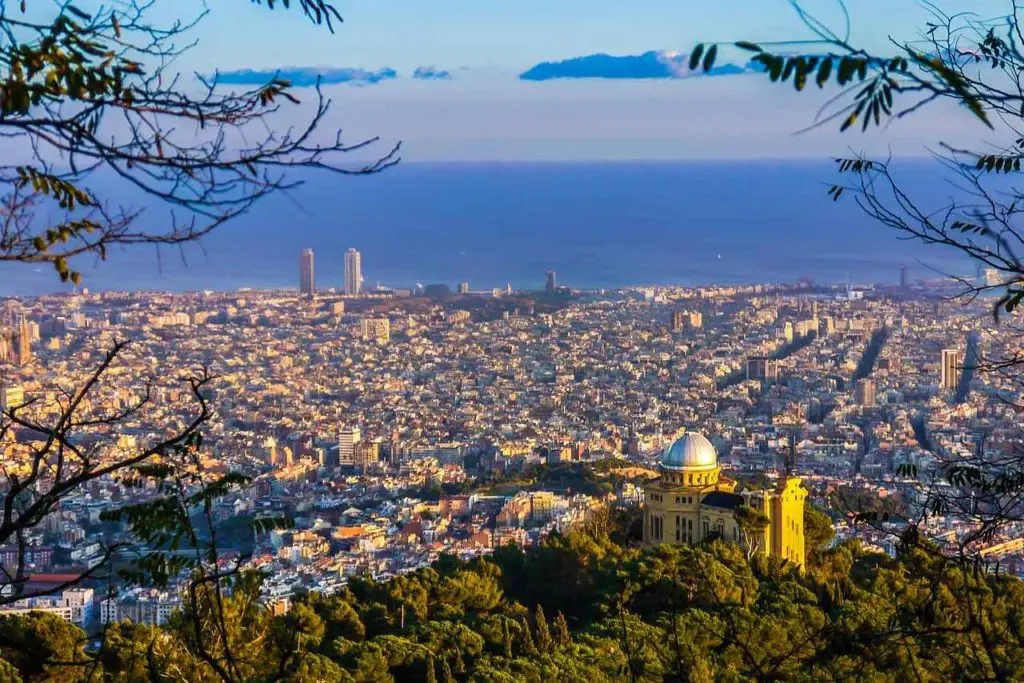
As the starting point for the road trip, Barcelona is one place you’ll definitely be visiting. One thing you shouldn’t do is fly into the city only to leave straight away.
With so many things to do in Barcelona, it would be madness to leave without having a look around. My advice is to spend a few days in the city and then get onto the road.
Sagrada Familia, Parc Guell and Camp Nou are all places you have to check out while you’re in the city. If you visit during the summer, you can head to Barceloneta and visit the beach too.
Barcelona is one of the main tourist spots in Spain and for good reason. There are lots of famous landmarks in Barcelona and lots to see and do. As a first point on the drive, it’s not a bad place to start!
Cuenca
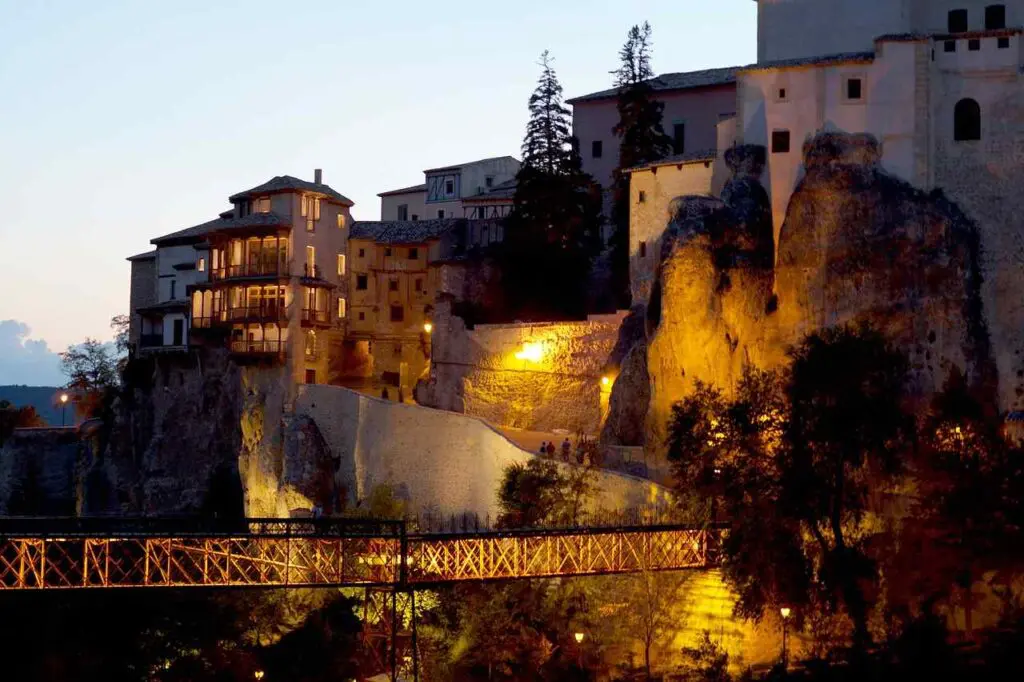
Cuenca is one of the most scenic places you can visit in Spain. The city is located on hilltops above a gorge which gives it an otherworldly feel.
The hanging houses as they are known, stand out over the gorge of the river Huecar. It’s an impressive sight and one that will grab your attention, but there are a lot of other things to see in Cuenca too!
You can check out the impressive town square at Plaza Mayor and marvel at the 12th-century cathedral. While you’ll also find the Museum of Spanish Abstract Art in the city, which is worth a visit.
Cuenca is a great stop while driving from Barcelona to Madrid and the plethora of things to see ensures it’s somewhere you won’t forget in a hurry!
Toledo
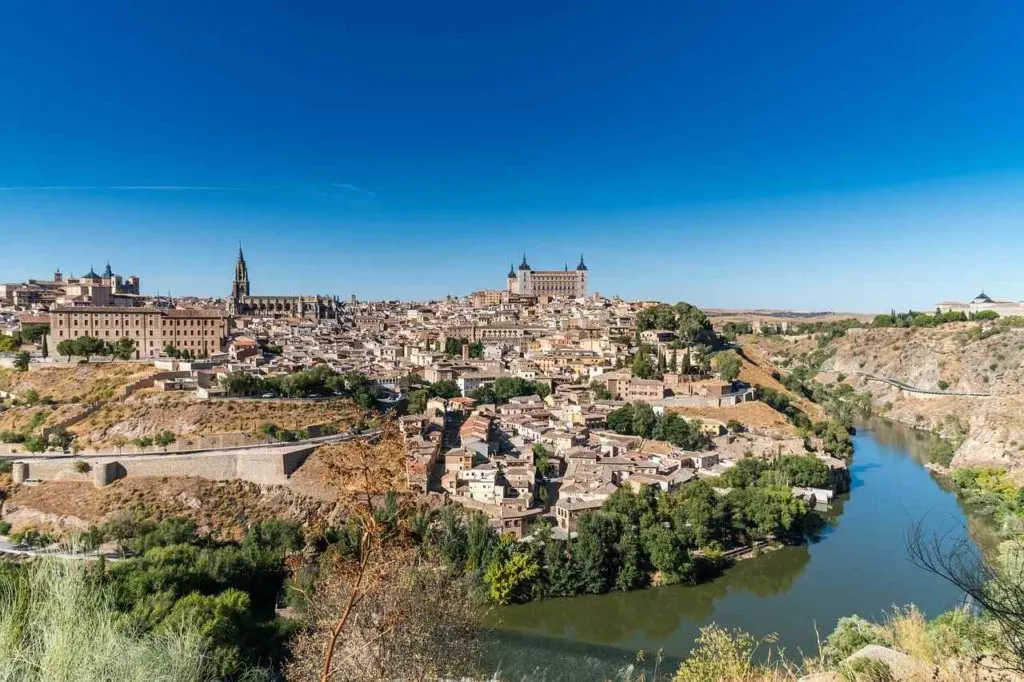
Toledo is one of Spain’s hidden gems and an ideal place to visit on this road trip. A lesser-known fact about the city is that it used to be Spain’s capital from 542 to 725 AD.
After over two thousand years of people living in Toledo, there is a lot of history in the city. This is one of the primary reasons to visit.
You’ll find a lot of historical buildings to explore such as the Alcázar de Toledo, a Roman fortress built in the 3rd century which was later converted into a palace in the sixteenth century.
You can also visit the Santa Iglesia Catedral Primada de Toledo, Monasterio de San Juan de Los Reyes and the Mosque of Cristo de la Luz while you’re in the city!
As one of the last stops before Madrid, it’s a brilliant place to explore for a day and spend a night!
Tarragona
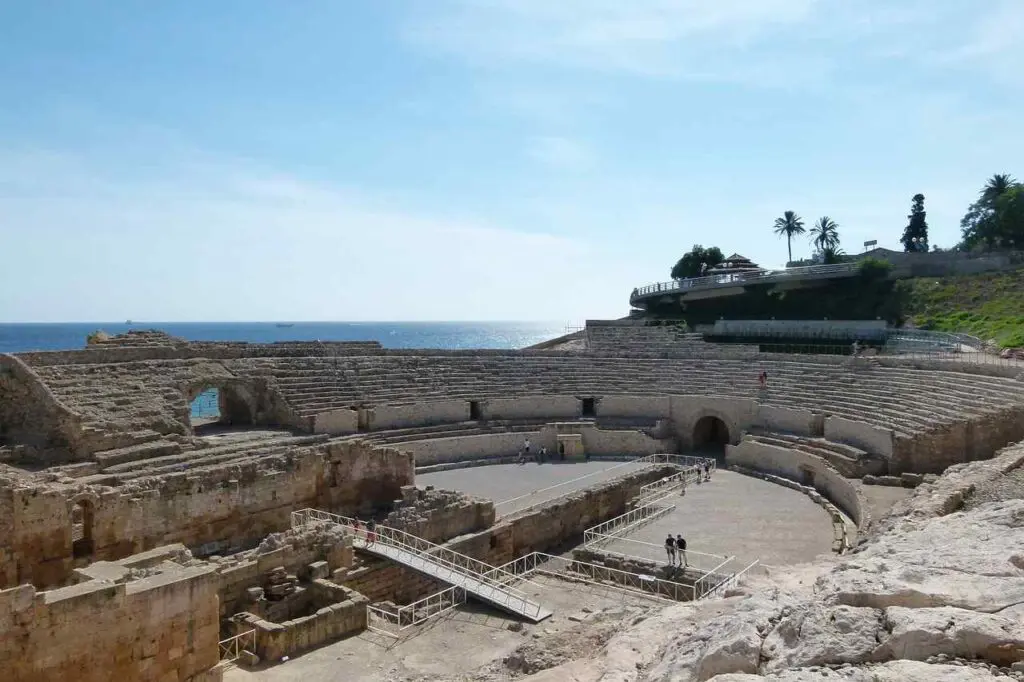
Tarragona is one of the best places to visit in Catalonia and one of the first stops on the way to Madrid.
The reason is that there is a lot to do here. As the city is located on the Costa Daurada, you can relax at the beach if you want. It’s a popular resort for many holidaymakers, so the beach is one of the best in the country.
Perhaps the best part about Tarragona is the wealth of historical sights in the city. Tarragona is over four thousand years old and the Roman amphitheatre is evidence of this.
You can also check out many more sights such as the walls, Necropolis and Palace of Augustus. This is enough to fill a day and if you’re a history it might be a good idea to stay for a day or two to see everything!
Valencia
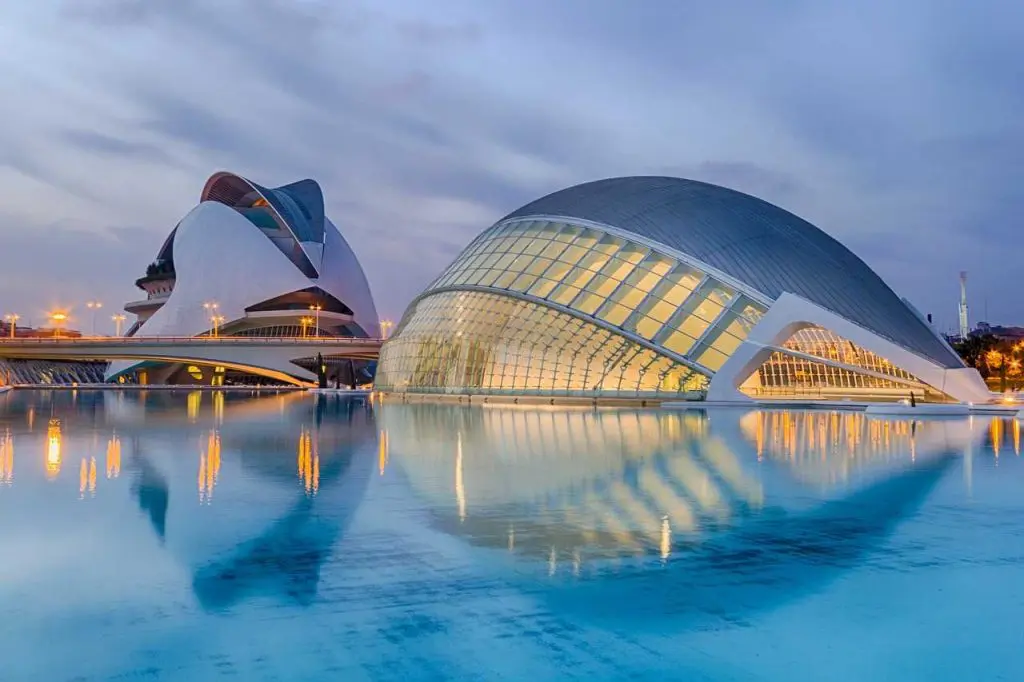
Valencia is one of my favourite cities in Spain. It’s not as big as Barcelona or Madrid but it’s still got a lot going for it. The fact it’s smaller than those two cities gives it a more intimate feel.
It’s quieter and if you head to the right place, it can feel like you’re not even in the middle of a big city. This is especially true around the City of Arts and Science complex!
This is the biggest draw in Valencia and the sight of the white buildings which resemble will blow your mind. There are lots of older buildings in the city such as the Cathedral and Mercado which should also be visited while you’re in the city.
A quirkier aspect of Valencia is the marina area. This is where you can find the disused Formula 1 track and hangars from the America’s cup. It’s also right next to the beach, which makes an ideal stop after you’re finished exploring!
Check out my Valencia travel guide for more info on what to do in this great city!
Things To Do On a Barcelona to Madrid Drive
The good thing about this road trip is that there are a lot of things to do along the way. Not only will you visit some of the best cities in Spain, but you’ll get to see some great beaches and natural sights too!
Below are a few of my suggestions for what you can do during the drive.
Watch a Football Match
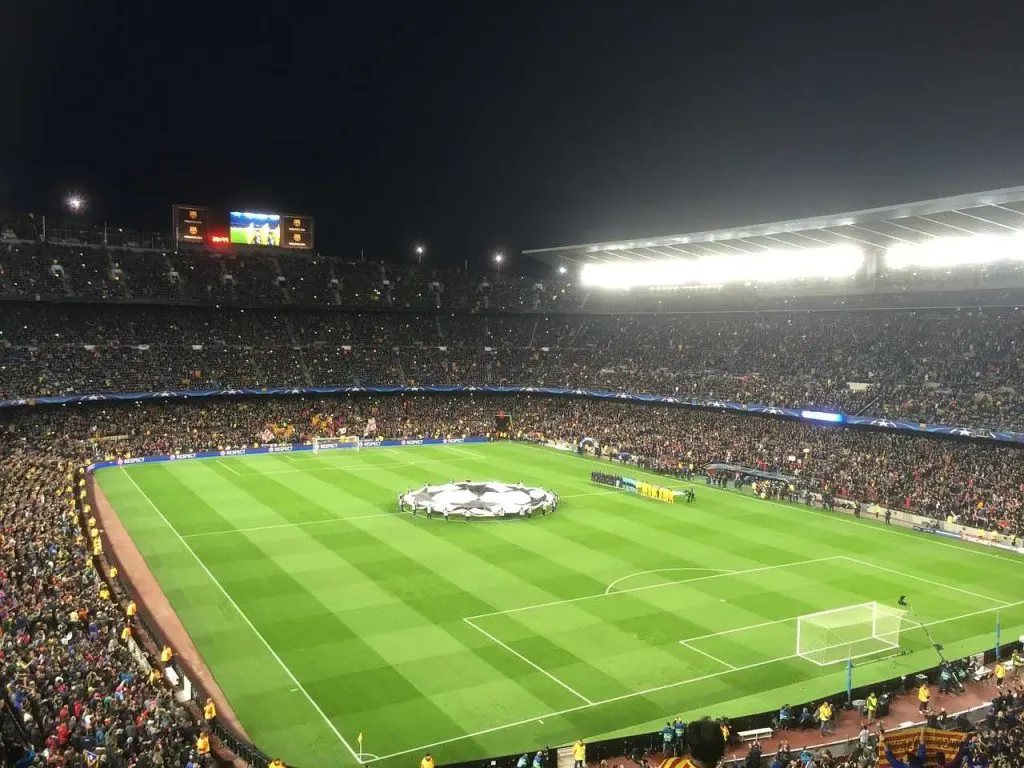
Spain is a football-mad country and if you’re doing this road trip during the football season, you should be able to watch a match at either Barcelona, Madrid or Valencia.
When I lived in Barcelona, I went to Camp Nou a few times to watch Barcelona play and it was an incredible experience. It’s hard to describe just how big the stadium is and the atmosphere it can generate.
When I was in Valencia, there was no match being played, so contented myself with a tour of the stadium, while I never got around to visiting the Bernabéu or Metropolitano in Madrid.
Even if you’re not a sports fan, watching a football match in Spain is a cultural experience that you should take in while you’re in the country. Spain lives, breathes and sleeps football, to miss out on what could be a once-in-a-lifetime experience would be a shame.
Head to the beach
The great thing about this Barcelona to Madrid drive is that you can visit some of the best beaches in Spain before you make your way inland.
From Barcelona down the coast to Valencia you have a large choice of beaches to stop at and take a break from driving.
As Tarragona is one of the stops on the drive, you could spend the day at the beach before checking out the city afterwards.
The same applies to Valencia and its huge beach. If you visit the city during the summer, it’s a great place to visit to cool off in the Mediterranean!
Example Barcelona to Madrid Drive Itinerary
Naturally, this road trip will start from either Barcelona or Madrid. It works well going in either direction, which way you go is up to you.
This itinerary is an example to show you what you can do on the route. If you wish to change it up, visit different places, or skip a destination, that’s entirely up to you!
Day 1 – Barcelona to Tarragona
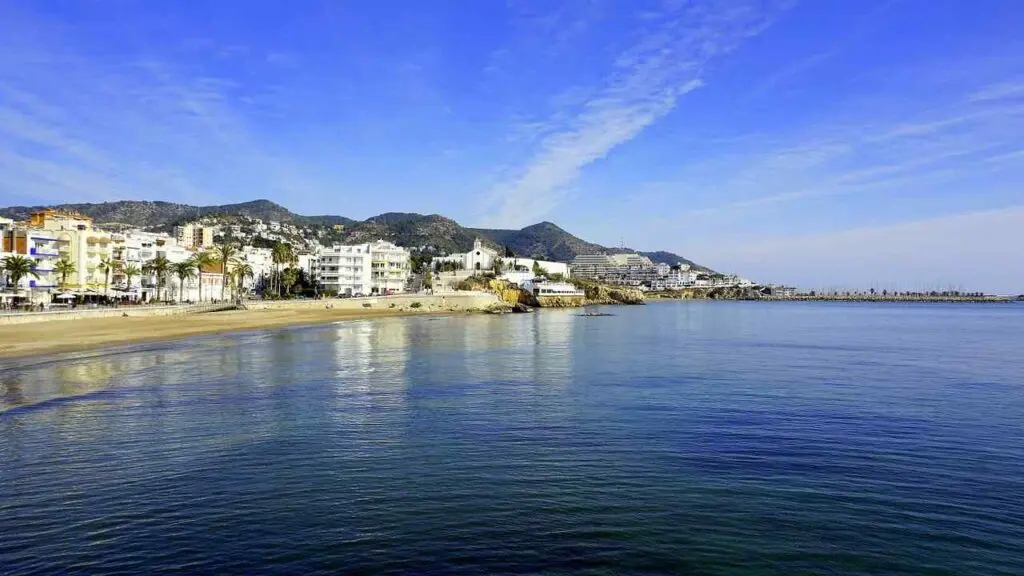

Distance
99.6 km (61.8 miles)

Time without stops
1 hour 15 minutes
Before you start the trip, my advice is to spend a minimum of 3 days in Barcelona. There’s a lot to see in the city and it would be a shame to get there and leave straight away on this trip.
Once you start the trip, the drive from Barcelona to Tarragona is a short one at just over an hour. However, you’ll find a lot of places to stop along the way if you wish.
One place to stop is Castelledefells which has a fantastic beach. On a side note, this is where Barcelona footballer Leo Messi lives. If you’re lucky, you may bump into him while you’re in the town.
Another place you can stop is at Sitges. It’s a more built-up version of Castelldefels. I wouldn’t stop at both places unless you really like beaches. My advice would be to choose one to stop at beforehand and then drive onto Tarragona from there.
Once you get to Tarragona, you’ll find a lot of stuff to do. Again, you can head to the beach if you wish. But if you’ve spent the day at the beach already, then you might not be keen to spend more time there.
Instead, you should check out the many historical sights that I mentioned above. Tarragona has a lot of Roman ruins and they are well worth checking out.
The amphitheatre, in particular, is an amazing sight. Spend your remaining time in the city checking out all the sights is a good idea before you make your way to Valencia.
Day 2 – Tarragona to Valencia
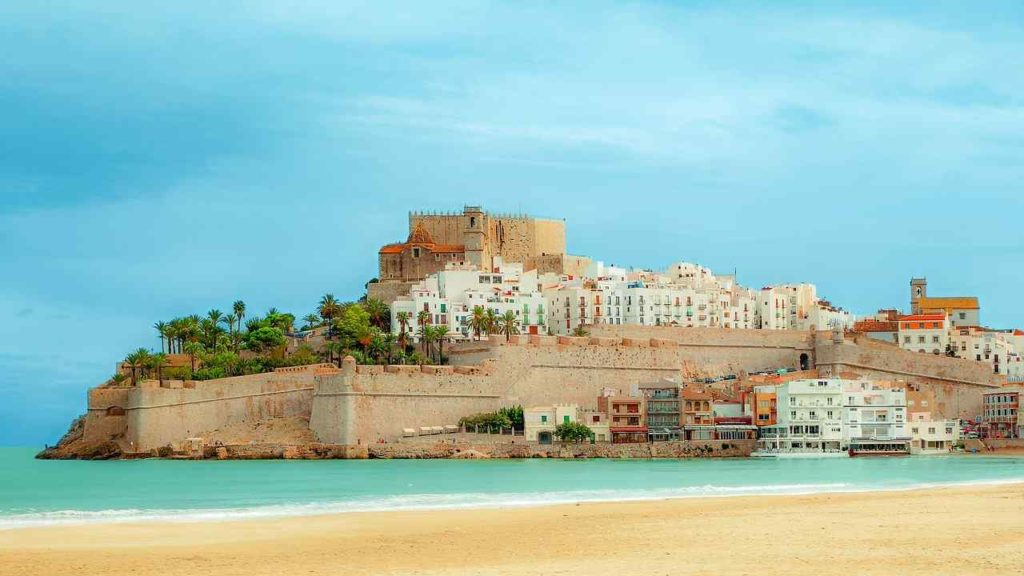

Distance
259 km (160.9 miles)

Time without stops
2 hours 29 minutes
The drive from Tarragona to Valencia is the longest of the road trip at two hours and 29 minutes. This isn’t a long drive by any stretch of the imagination, but compared to the other legs of the trip it takes a lot more time.
The good thing is that the drive is worth it and there are a few places you can stop along the way. One such place is Peñíscola.
It’s a small town located halfway between the two cities and is worth stopping at for lunch or a long break. It’s known as the Gibraltar of Valencia as Peñíscolais a fortified seaport connected to the mainland by a small strip of land.
The castle that stands on the headland was built by the Knights Templar in the 13th century and is an imposing structure.
It’s worth checking out of you have the time. You’ll get excellent views from the high vantage point and you can learn about the castle’s fascinating past by going inside and taking a look around.
After that, the drive to Valencia is fairly straightforward with not many places to stop. You’ll probably arrive in the city in the late afternoon, or the evening. this gives you time to take a quick look around the city, get something to eat and explore the rest of the city the following day!
Day 3 – Valencia
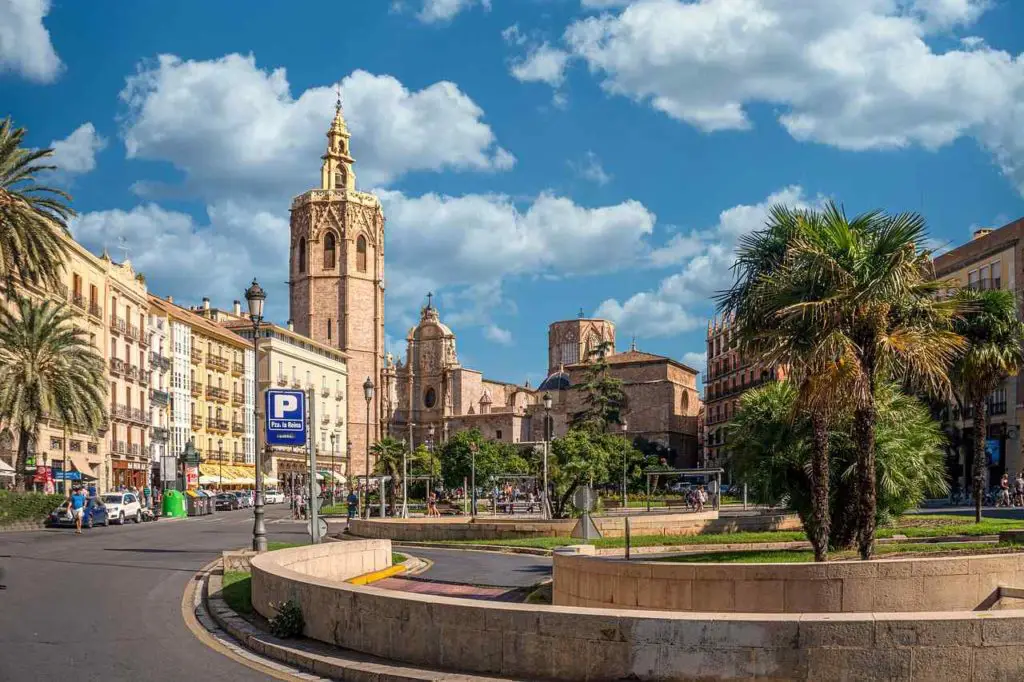
Driving to Valencia only to leave the next day would be a waste, so I suggest you spend a full day in the city to see as much as you can.
With so many fun things to do in Valencia, you won’t have difficulty making the most of your day in the city! The only problem is knowing where to start!
As I mentioned above, the City of Arts and Sciences is a must-see in Valencia. The buildings are unlike anything I’ve ever seen before. They house several museums too which you should check out.
Valencia has a lot of historic buildings such as the Cathedral and Mercardo. Both of these buildings are incredible to look at, in you can look around them too. In the case of the Mercado, you can browse a variety of fresh food and eat at one of the cafes too.
Perhaps my favourite part of Valencia Turia Park. This is a gigantic park the snakes all the way from the centre of the city all the way to the City of Arts and Sciences.
I can’t emphasise who big this park is, it stretches for a good few miles. The beauty of the park is that although you’re in the middle of a big city, it doesn’t feel like it! You can go for a walk, relax, and feel like you’re in a peaceful town!
As well as these places, you should check out the Marina area. This is one of the strangest parts of the city, as it hosted a Formula 1 race and the America’s Cup back in the early 2010s but has since been left in a state of disuse.
It’s interesting to walk around here and see how few people there are and the remnants of a Formula 1 track and disused warehouses!
Day 4 – Valencia to Albacete
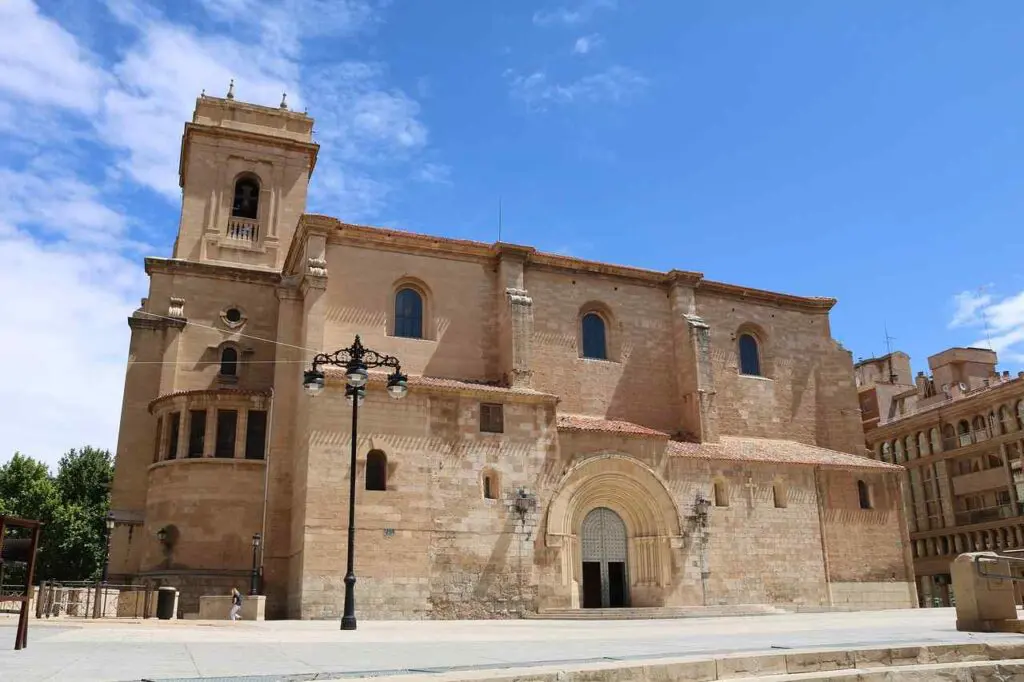

Distance
185 km (114.9 miles)

Time without stops
1 hour 52 minutes
The drive from Valencia to Albacete takes just under two hours and sees you move from the coast to inland Spain.
One place to stop along the way is Xàtiva. It’s only a small town and not far from Valencia, but you should check it out nonetheless.
The town is home to an imposing castle that sits atop a peak near the town. It was first built in 218 BC and served as a lookout point along the Via Augusta route which stretched from Rome to Cadiz.
The views from the castle are magnificent and it’s well worth the walk up to the castle. After this, you won’t find too many places to stop before Albacete.
This is one of the least populated parts of Spain, and it’s mainly small towns that dot the route. Once you get to Albacete, you should have a large portion of the day to explore the city.
It’s not the most well-known city in Spain, but there are still a few things to see. Like most cities in Spain, it’s full of historic buildings and museums which are worth venturing to.
While the Pasaje de Lodares is a walkway that has some stunning architecture you can’t miss!
Day 5 – Albacete to Cuenca
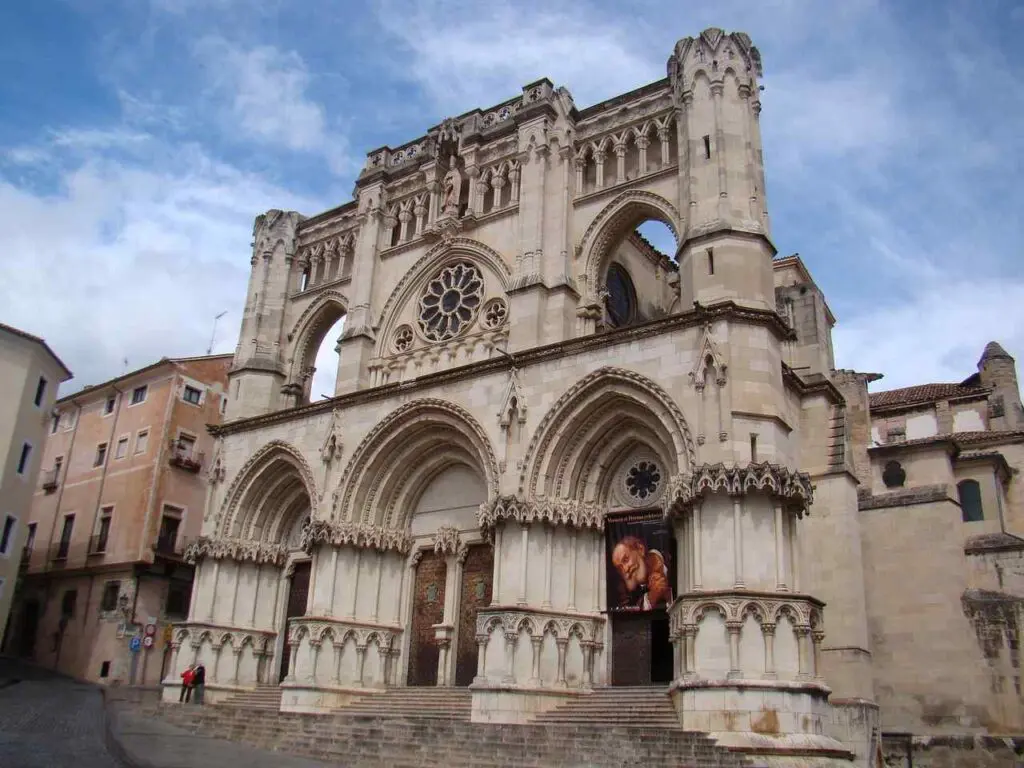

Distance
160 km (99.4 miles)

Time without stops
1 hour 42 minutes
The drive from Albacete to Cuenca takes about an hour and forty-five minutes. This is another trip across the heart of Spain that will see you pass by a lot of small towns.
There isn’t really much to see during the drive and apart from the odd stop to take a break, it might be best to drive straight to Cuenca.
Once you’re in Cuenca, you’ll find a city that is one of the most scenic in Spain. The sight of houses atop the edge of the gorges will leave you speechless.
It’s a good idea to get to Cuenca as quick as you can so you have more time to explore the city. You’ll find a lot to see as well as admire the houses from the base of the gorge.
The city was listed as a UNESCO World Heritage site in 1996 and some interesting museums that display abstract and paleontology.
You’ll also find lots of colourful houses and historic buildings dotted throughout the city too!
Day 6 – Cuenca to Toledo
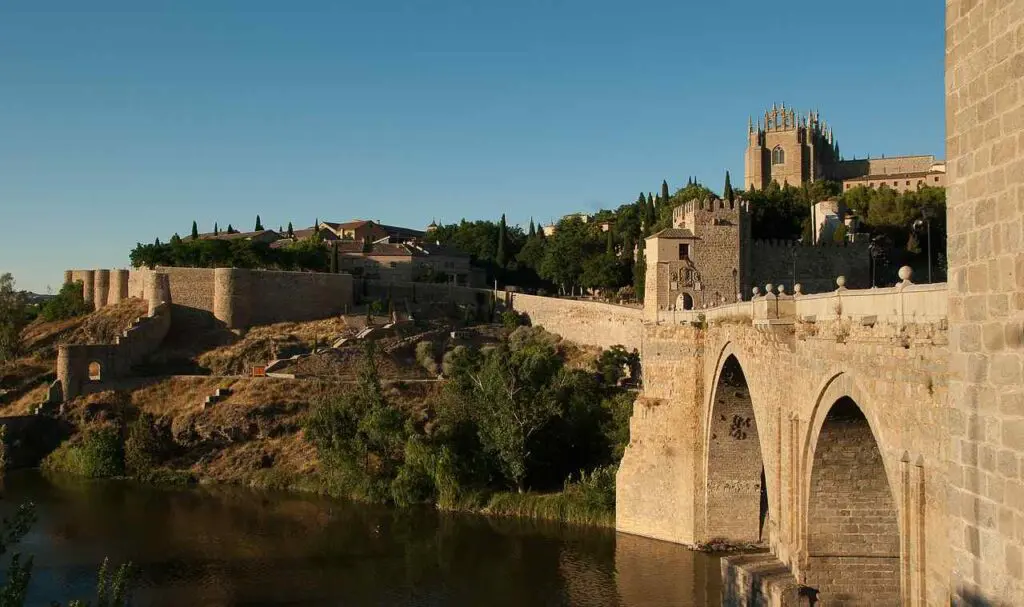

Distance
179 km (111.2 miles)

Time without stops
1 hour 43 minutes
The penultimate leg of the drive sees you go from Cuenca to the old capital, Toledo. This will see you come back out of the wilderness and into a more populated area of the country.
The first part of the drive from Cuenca along the A-40 doesn’t have much to see. One thing you could do is spend more time in Cuenca and explore the nearby national park.
If you love hikes and want to see more stunning scenery, it’s well worth doing. Given that the drive takes just under two hours, you could spend a large part of the day there and still get to Toledo in the afternoon and find time to take a look around.
Whatever you decide to do, you’ll find plenty of things to see in Toledo. As the old capital, it has a plethora of historical buildings for you to check out.
The Alcazar, a fortress built in 1085, dominates the skyline and should be your first port of call. The sheer amount of churches and cathedrals in the city is a testament to the importance of the city during those times.
My advice for your time in Toledo is to walk around and take everything in. Make sure you head to Mirador del Valle to get the best view of the city in all its glory!
Day 7 – Toledo to Madrid
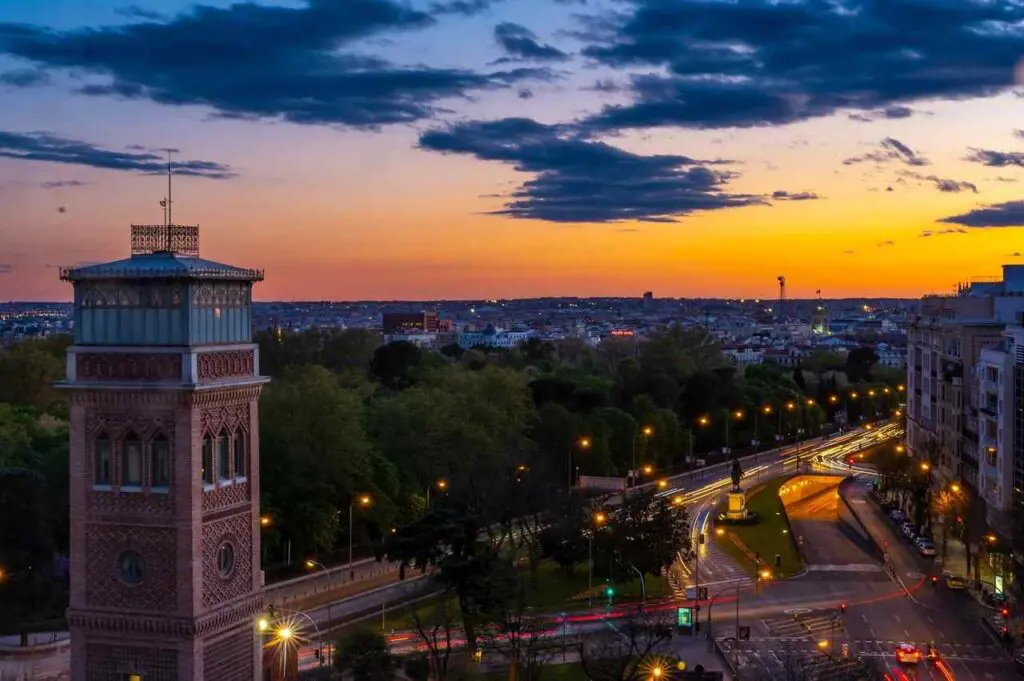

Distance
73.1 km (45.4 miles)

Time without stops
54 minutes
The final leg is the shortest part of the trip. It takes just under an hour to drive from Toledo to Madrid. This gives you a few options.
You can spend a portion of the day in Toledo seeing more of the city. This is a good idea if you got there late the previous day. Or, set off early and spend the majority of the day in Madrid.
What you do is up to you and might depend on your plans after you get to Madrid. With so much to do in the capital, it would be a waste to get there and leave the next day. You can see a lot during 24 hours in Madrid, but more time is not to be sniffed at.
I recommend you plan at least 3 days in Madrid afterward so you can see everything. It’s hard to describe what you should do in one day but it will depend on your preferences.
For culture vultures, The Prado is one of the most popular art museums in Spain and has several famous pieces in its collection such as David with the head of Goliath by Caravaggio.
You can head to the Bernabéu, home of one of the most famous football teams in the world, Real Madrid. A stadium tour is essential even if you’re not a fan of the club.
If you want to get a feeling for the beating heart of the city, a visit to Gran Via is a must. This is the main street in Madrid and it’s home to many shops and restaurants.
How Much Does a Barcelona to Madrid Drive Cost?
One thing that is unavoidable on any road trip is that you will spend money. It doesn’t matter how long or short your drive is, it’s going to cost money regardless!
One of the benefits of doing a road trip in Spain is that compared to other countries in Europe. You will spend a lot less in Spain daily than you will in places such as Germany and the Netherlands.
An area of cost that will be eliminated if you do the trip in a campervan, will be accommodation. While it’s not expensive in Spain, if you’re in a group of four, renting a campervan is a good way to reduce costs.
Here’s a link to a fuel cost calculator, which will be useful on the trip. Using the fuel price data from a Google search for “petrol prices Spain”, input the figure into the calculator and you’re set.
I got a quote of €1.16 per litre driving the distance in a car with average fuel consumption of 5.7 litres per 100km. This led to a total of $63.19 for the trip. Considering the distance covered, that is a very reasonable price!
Even if there are only two of you on the trip that is a good price. The cost of renting a car is around €60 a day, add in food and drink, any tours and activities you may do and the cost of the trip comes to about €200 per person.
This is fantastic value for money considering how much you get to see on the trip and the mileage you’re doing. If you want a fun holiday in Spain, a Barcelona to Madrid road trip is a great idea that won’t cost the earth!
Need a Rental Car?
I use Rentalcars.com whenever I need to rent a car. They offer the most comprehensive listings of rental cars on the web. Plus, their deals are often cheaper than if you went straight to the supplier!
Need Travel Insurance?
SafetyWing offers coverage that will give you peace of mind while you’re on the road. If you want to protect yourself while you’re on the road, then click the image to take a look at the options available to you.
Concluding Thoughts
The road trip from Barcelona to Madrid is one of the best in Spain. You’re going between the two biggest cities in Spain and seeing lots of exciting places along the way!
Have you done a Barcelona to Madrid drive? Did you do a similar itinerary to mine? Is there anything I have missed out?
Leave me a comment below and let me know your thoughts!
Pin For Later
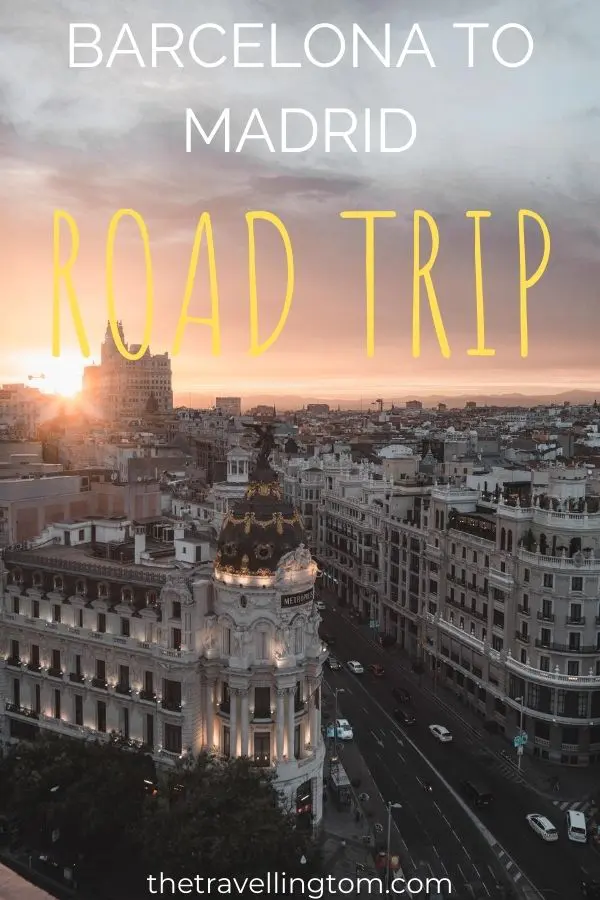
Tom is a travel addict who first left England to spend a year Down Under. Not satisfied with this, he then went to New Zealand, about as far away from home as he could get. He is now planning his next adventures in Europe and Canada while maintaining this blog. Check out the about me page to learn more!

